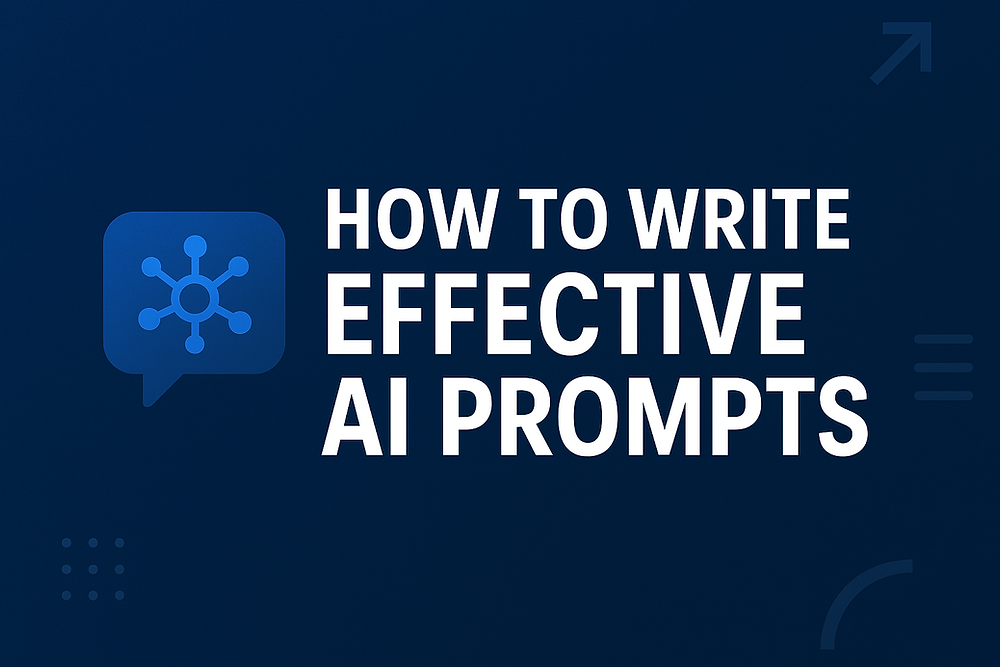Introduction: Why Good Prompts Matter
Ever asked an AI to “write a blog post” and received something bland or unhelpful? That’s not the AI’s fault—it’s the prompt. The way you phrase your request determines whether you get generic text or a polished, insightful answer.
If you’ve ever wondered how to write a good prompt, you’re not alone. Prompting is quickly becoming one of the most valuable skills in the digital age. The good news? Anyone can learn it.
This guide will walk you through seven practical tips to craft better prompts, with tools and frameworks that help you unlock AI’s full potential.

1. Be Clear and Direct
AI thrives on clarity. Instead of saying:
❌ “Write about marketing.”
✅ Try: “Write a 600-word blog post explaining why small businesses should use social media marketing, with three actionable strategies.”
Being precise gives AI a blueprint to follow.
2. Provide Context
Context transforms average responses into tailored ones. Include:
- Audience → Who are you writing for?
- Purpose → Inform, persuade, entertain?
- Format → Blog, listicle, social post, script?
Example: “Write a motivational Instagram caption (under 150 words) for students preparing for exams.”
3. Add Constraints for Creativity

Boundaries spark better results. You might specify:
- Word count: “Write in 100 words.”
- Style: “Explain in a conversational tone.”
- Perspective: “Tell it from a first-person viewpoint.”
AI performs best when the sandbox is well-defined.
4. Use Frameworks and Structures
Borrow proven frameworks to guide AI:
- AIDA (Attention, Interest, Desire, Action) → perfect for ads.
- Problem-Agitate-Solution (PAS) → useful for persuasive copy.
- Three-Act Story → ideal for creative writing.
If you’re new, My Magic Prompt’s Prompt Templates can save you time by offering pre-structured formats.
5. Break Complex Tasks Into Steps
Instead of one giant prompt, use a chain:
- Ask for an outline.
- Expand one section.
- Refine tone or polish style.
This layered prompting yields higher quality results.
6. Experiment With Tone and Voice

AI is versatile—use it. Try:
- Professional tone for LinkedIn.
- Playful humor for TikTok.
- Poetic or literary voice for storytelling.
You can even ask AI to mimic famous authors or brand voices.
7. Save and Reuse Your Best Prompts
Great prompts shouldn’t be one-offs. Keep a prompt library so you can adapt proven ones for future tasks.
The Magic Prompt Chrome Extension makes this easy—you can organize, tag, and reuse your favorite prompts without clutter.
How My Magic Prompt Helps You Write Better Prompts
Sure, you can write prompts manually, but My Magic Prompt accelerates the process:
- Prompt Builder → structure your ideas quickly.
- Templates → start with proven frameworks.
- AI Toolkit → manage prompts across different workflows.
Learn more on the My Magic Prompt homepage.
FAQs on Writing Good Prompts
1. What’s the difference between a good and bad AI prompt?
A good prompt is specific, contextual, and structured. A bad one is vague, leaving the AI guessing.
2. How do I make my prompts more creative?
Add style constraints, perspectives, or unusual scenarios. Example: “Write a product review in the voice of a pirate.”
3. Can prompts be reused across platforms like ChatGPT, Claude, or Gemini?
Yes—though each model may respond slightly differently, well-structured prompts work across all.
4. How can I organize my prompts for future use?
Use tools like the Magic Prompt Chrome Extension to store and categorize prompts.
5. Where can I learn more about prompting best practices?
Check out this Harvard Business Review article on AI productivity or OpenAI’s official guide.
Final Thoughts
Knowing how to write a good prompt isn’t just a trick—it’s the foundation for working smarter with AI. By being specific, structured, and creative, you’ll unlock responses that are not just useful, but inspiring.
👉 Want a head start? Explore My Magic Prompt for templates, prompt builders, and an AI toolkit that makes prompt engineering effortless.

